Ramen noodles are an essential part of many diets around the world. Whether you’re a college student, busy parent, or hard worker, chances are ramen noodles have been there to get you through a few meals. But what are ramen noodles made of? Understanding the ingredient list and nutrition facts can help you make informed decisions on when and how often to enjoy these convenient bites. In this blog post we’ll dive into all things ramen noodles – from the ingredients used to make them, their nutrition value, and ideas for better-for-you alternatives that still meet our craving for an occasional bowl.
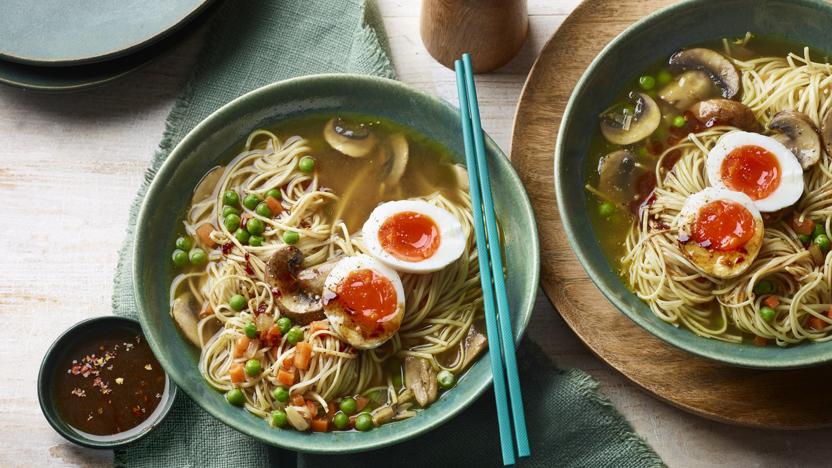
Contents
What Are Ramen Noodles?
Before learning about what are ramen noodles made of, let’s find out what they are. Ramen noodles are a type of Japanese noodle dish that has become popular around the world. They are made from wheat flour, salt, water, and sometimes egg. Ramen noodles can be served hot or cold and is often topped with a variety of ingredients such as vegetables, meat, fish, eggs, seaweed and more. There are many different types of ramen noodles, from the classic miso ramen to the spicy tonkotsu.
The Origin Of Ramen Noodles
Ramen noodles are believed to have originated in China during the 19th century, and were popularized in Japan over several decades. The term ramen is derived from the Chinese word “la mian” which translates to “pulled noodles”. In 1958, instant ramen was invented and has since become a staple for many households. Today, they can be found in a variety of flavors, shapes, and sizes all around the world.
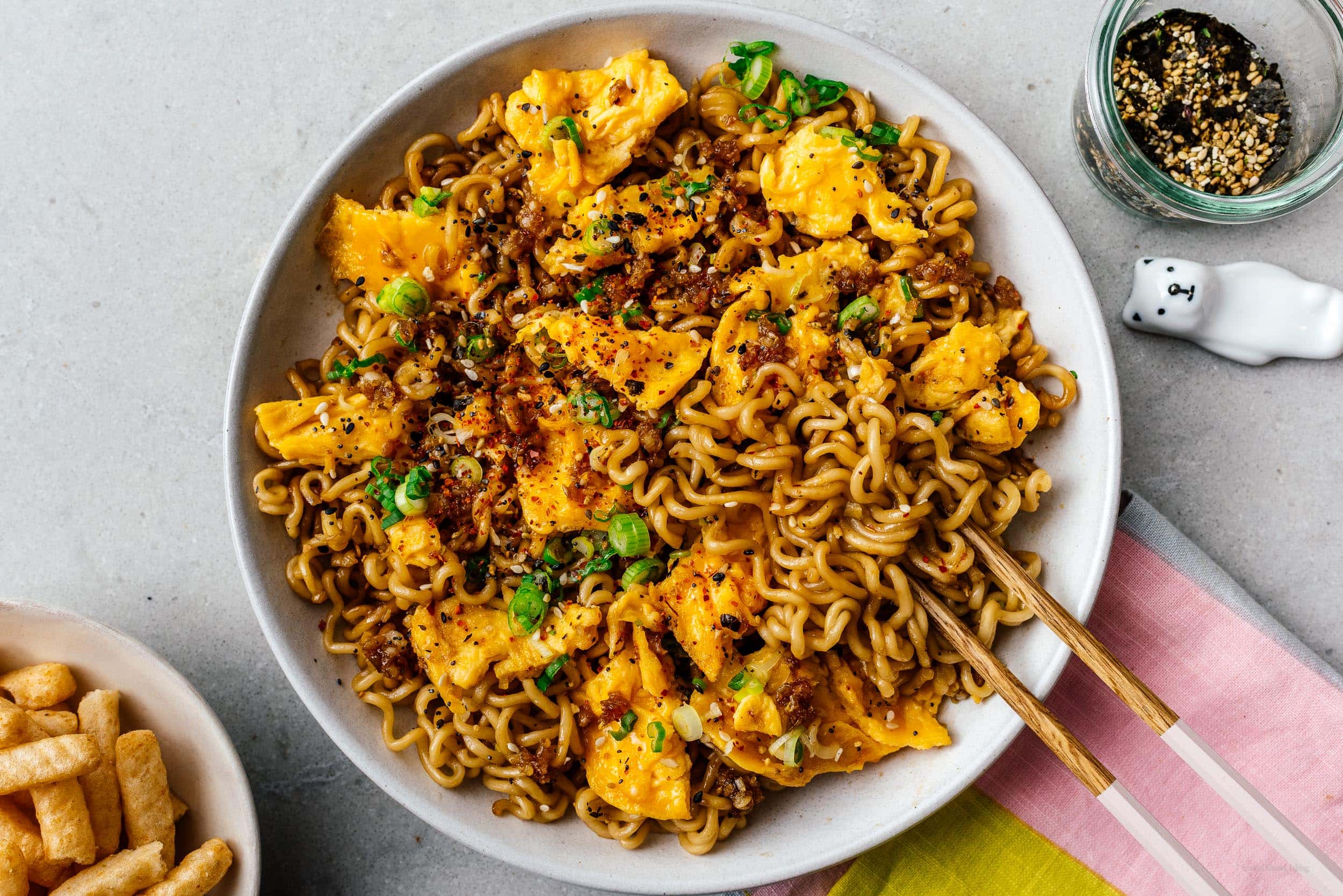
What Are Ramen Noodles Made Of?
Ramen noodles are typically made with wheat flour, salt, water, and kansui (alkaline mineral water). Kansui gives the noodles their firm texture and yellow hue. Instant ramen also includes MSG, a flavor enhancer that gives the noodles their signature salty taste. Commonly used seasonings for ramen noodles include miso, soy sauce, and sesame oil. Most store-bought packages of ramen also contain dehydrated vegetables like carrots, onions, and mushrooms.
Let’s watch this video to know more about what are ramen noodles made of.
How Are Ramen Noodles Made?
Ramen noodles are typically made using a combination of wheat flour, salt, and water. Depending on the type of noodles being made, eggs may also be added to give them a slightly richer flavor. The wheat flour is mixed with boiling water until it forms a paste-like consistency. This dough is then kneaded and cut into thin strips which are dried or steamed to create the noodles.
5 Different Types Of Ramen Noodles
- Shoyu Ramen: Shoyu ramen is one of the most popular types of ramen noodles and is made with a soy sauce-based broth. It’s usually topped with chashu pork, bamboo shoots, nori seaweed, and scallions.
- Miso Ramen: This type of ramen is made with a miso (fermented soybean paste) based broth, and is usually topped with bean sprouts, ground pork, seaweed, and scallions.
- Tonkotsu Ramen: This type of ramen has a rich pork-bone based broth and is often topped with chashu pork, bamboo shoots, and soft-boiled eggs.
- Tsukemen: This type of ramen is served cold and consists of two separate dishes — noodles and a dipping broth. The dipping broth is usually a thicker, more concentrated version of the soup used in other types of ramen.
- Yuzu Shio Ramen: This type of ramen has a clear, light broth that is flavored with yuzu (a type of citrus fruit) and salt. It’s usually topped with chashu pork, bamboo shoots, seaweed, and scallions.
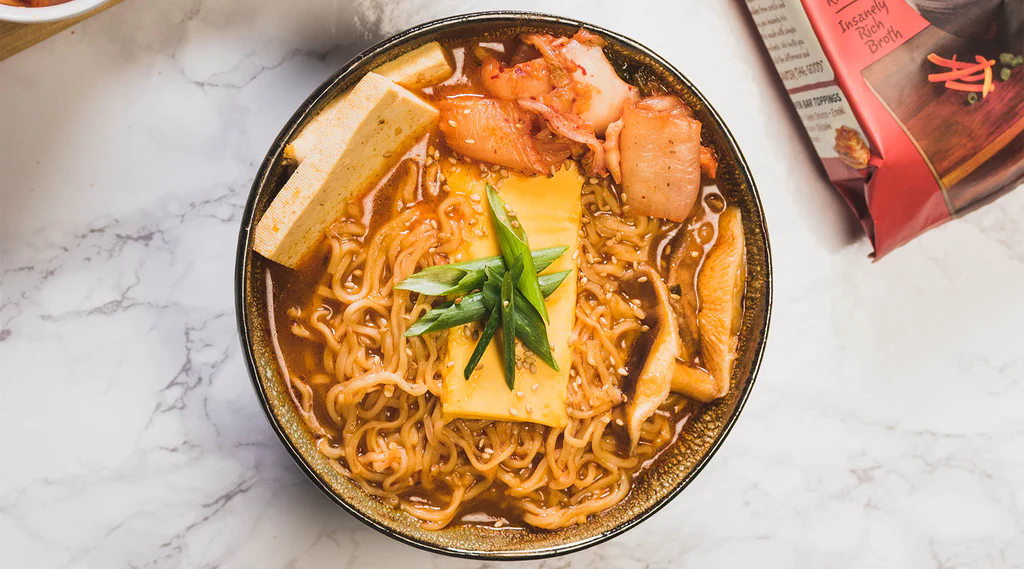
5 Regional Styles Of Ramen Noodles
- Hakata Ramen: This type of ramen originates from Fukuoka, Japan and is most commonly known for its thick, rich pork-bone based broth. It’s usually topped with chashu pork, bean sprouts, scallions, and soft-boiled eggs.
- Sapporo Ramen: This type of ramen originates from Sapporo, Japan and is known for its thick miso-based broth. It’s usually topped with butter, sweetcorn, bamboo shoots, and pork slices.
- Tokyo Ramen: This type of ramen originates from Tokyo, Japan and is made with a clear chicken or seafood based broth. The noodles are typically thick and curly, and the toppings usually include Nori seaweed, bamboo shoots, pork slices, and hard boiled eggs.
- Kyushu Ramen: This type of ramen originates from Kyushu Island in Japan and is made with a thin, clear pork-bone based broth. It’s usually topped with chashu pork, bamboo shoots, and scallions.
- Osaka Ramen: This type of ramen originates from Osaka, Japan and is made with a soy sauce based broth which is usually thicker than other types of ramen. It’s usually topped with sliced pork, bean sprouts, seaweed, and soft-boiled eggs.
How To Make Ramen Noodles At Home?
Ingredients Needed To Make Ramen Noodles At Home
- 2 cups of all-purpose flour
- 1 teaspoon of salt
- 1 cup of boiling water
- Optional: 1 egg (for an extra rich flavor)
Step by Step Instructions On How To Make Ramen Noodles At Home
- In a medium bowl, combine the wheat flour and salt.
- Add the cooking oil and mix until everything is well combined.
- Slowly add the boiling water, stirring continuously to create a dough-like consistency.
- Knead the dough for about 5 minutes on a floured surface until it’s smooth and elastic.
- Cover the dough with a damp cloth and let it rest for 30 minutes.
- After the dough has rested, roll it out as thin as possible.
- Cut the dough into long thin strips and lay them on a floured surface.
- Let the noodles dry for at least 30 minutes before cooking or storing in an airtight container.
- When ready to cook, bring a pot of salted water to a boil and add the noodles. Cook for 3-5 minutes or until desired texture is reached.
- Drain the noodles and serve with your favorite ramen toppings!
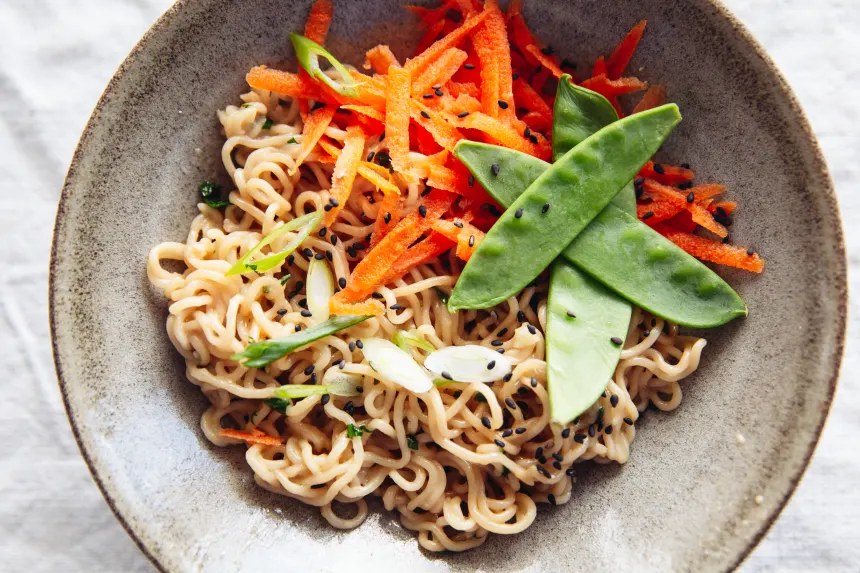
Tips To Make Ramen Noodles Perfectly
- Use the right type of flour: Wheat flour is best for making ramen noodles, as it gives them the best texture and flavor.
- Knead the dough for at least 5 minutes: Kneading helps to make sure that all of the ingredients are evenly distributed throughout the dough.
- Roll out the dough as thin as possible: This will help the noodles cook evenly and give them the best texture.
- Let the noodles dry for at least 30 minutes: This allows them to fully absorb all of the flavors and prevents them from sticking together when cooking.
- Use plenty of salted water when boiling: The salt helps to flavor the noodles while they cook, giving them an extra boost of flavor.
- Experiment with different toppings: From vegetables to meats and even eggs, there are so many different topping combinations that can help make your ramen extra delicious!
- Enjoy your homemade ramen noodles! Nothing beats the taste of freshly made ramen noodles, so be sure to savor every bite and enjoy the fruits of your labor.
Ramen noodles are a delicious and versatile dish, perfect for any meal or snack! With the right ingredients and a few simple steps, you can easily make ramen noodles at home to enjoy whenever you like. So get cooking and enjoy the flavor of freshly made ramen noodles!
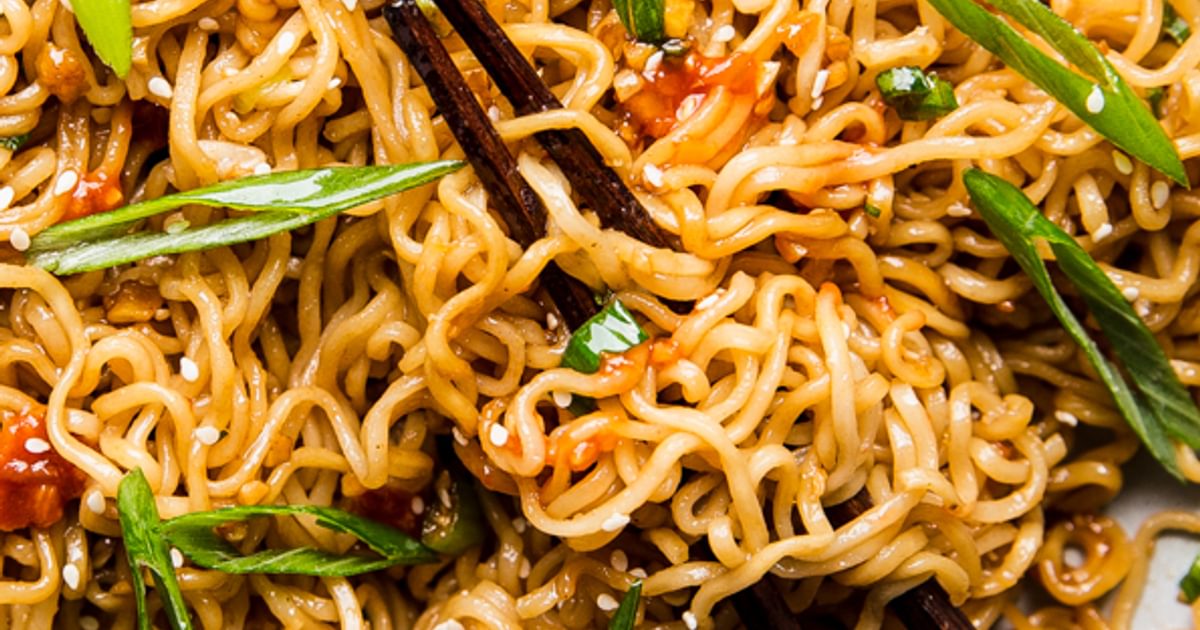
Conclusion: What Are Ramen Noodles Made Of?
So we have answered the question what are ramen noodles made of. Instant ramen noodles are typically fried in oil which makes them shelf-stable for a longer period of time than fresh or dried ramen noodles. Ramen noodles can be used in a variety of dishes, including soups, salads, stir-fries, and casseroles. While they are convenient and tasty, it is important to be aware of the potential health risks associated with consuming too much sodium and processed foods. There are also many other delicious types of noodles available around the world that you can explore and use in your everyday cooking. Thank you for reading at yongkangstreetnyc.com.
FAQs: Ramen Noodles
Are ramen noodles real pasta?
Contrary to popular belief, Ramen noodles are not considered pasta. Unlike traditional pasta made from durum wheat, Ramen noodles possess a distinct softer texture and smoother feel.
Is real Japanese ramen healthy?
While it does contain high fat, carbohydrate, and sodium content common in noodle dishes, it can lead to weight gain due to its calorie content. However, by keeping track of your daily calorie intake, you can enjoy one or two average-sized bowls per meal.
What’s the difference between ramen and noodles?
Unveiling the truth, noodles and ramen may share a common base of wheat flour. However, their individuality shines through in their composition, cooking techniques, and delicious flavors. Noodles, a versatile staple, can be transformed with a myriad of flavors. Ramen, on the other hand, boasts a unique umami taste derived from the harmonious blend of broth and seasonings.
Are Chinese noodles the same as ramen?
Ramen is the Japanese term for Chinese-style pulled wheat noodles, which were mentioned earlier. However, it is important to recognize that they are considered separate categories, especially due to their widespread availability in supermarkets, especially in their instant form.
Is Japanese ramen made with rice noodles?
Ramen noodles are actually created from a blend of high-quality wheat flour, water, salt, and the crucial element known as kansui. Join us as we unravel the secrets of this beloved culinary delight.
Why do Americans call instant noodles ramen?
This tantalizing Japanese adaptation of noodle soup has captivated taste buds worldwide. In fact, its allure is so strong that Japanese manufacturers often use “Ramen” to describe various flavors of instant noodles. In the United States, Ramen has become synonymous with all instant noodle products. This culinary sensation was born from the ingenious mind of Momofuku Ando, the visionary behind Nissin Foods in Japan.
Is the meat in ramen noodles real?
The seasoning packets that come with the noodles are typically not vegetarian, as they often contain ingredients like “powdered cooked chicken” or “dehydrated beef extract”.
Is Korean ramen noodles halal?
Look no further than Samyang ramyun. These halal Korean noodles are not only deliciously chewy and full of flavor, but also incredibly easy to prepare. With a variety of savory options available, the Hot Chicken & Cheese flavor stands out as a fan-favorite.
Why are ramen noodles so popular?
Ramen noodles have skyrocketed in popularity for valid reasons. Renowned for their versatility, ramen can be tailored to the chef’s preferences by incorporating a variety of exclusive ingredients, or simply enjoyed in its basic form. Beyond its culinary appeal, the true secret to ramen’s success lies in its affordability. Originally embraced as a nourishing option for busy individuals with limited time for meals, ramen emerged as the perfect dish for hardworking people seeking sustenance without compromising on taste.
How popular are instant noodles in Asia?
With over 100 billion servings consumed each year, instant noodles have become a staple in the region’s ready meals category. Originating from Japan, this beloved comfort food has experienced unprecedented appreciation in 2020.
Is ramen noodles halal or haram?
The noodles themselves are made with halal ingredients such as wheat flour, salt, water, and alkaline water. However, it’s important to be cautious of the flavorings that come with ramen noodle packages, as they may contain non-halal meat ingredients.
Can you digest ramen noodles?
Ramen noodles can put a strain on your digestive system. These highly processed noodles take a long time for your stomach to break down, causing disruptions in normal digestion. Furthermore, Ramen noodles contain Tertiary-butyl hydroquinone (TBHQ), a petroleum-based product that is difficult for the body to digest. This ingredient is also commonly used in lacquers and pesticide products.

Chef Yong Kang has over 20 years of experience cooking in the finest restaurants, and is excited to present their vision to you and all our guests. Our caring and committed staff will ensure you have a fantastic experience with us.
We are also available for private events:, business lunches, dinners, and more. We would love to discuss how to be a part of your next event.Our restaurant refuses to compromise on quality, which is why we source our fresh ingredients from local farmers’ markets.










